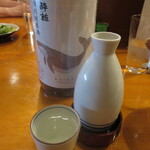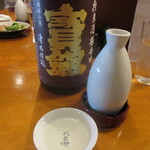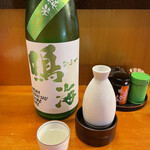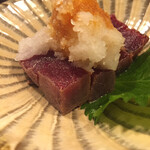
ぬる燗
Nurukan
3.53
Asakusa
「Izakaya (Tavern)」
3,000-3,999円
--
東京都台東区浅草3-20-9
Photos
(20)




















Details
Reservation Info
can be reserved
Payment Method
No credit cards
Electronic money is not accepted
QR code payment is not available
Number of Seats
14 seats
(10 seats at counter, 4 seats at tatami room)
Private Dining Rooms
Yes
(2 or 4 people allowed)
Smoking and Non-Smoking
No smoking at all.
Parking
None
Facilities
Counter seats available
Drink
Sake available, focus on sake
Dishes
Focus on vegetable dishes, fish dishes, health and beauty menus available
Comments
(20)
inoooooouuuue
3.00
I had always wanted to visit this place! When I arrived at 7:00, there were already 2 groups of customers. We took off our shoes and sat at the counter, which had about 10 seats and a kotatsu-like setting. It seemed like the owner really likes Laputa, as half of the interior decor was Laputa-themed! The menu was so extensive! As others have mentioned, I really respect the fact that it's a one-man operation. Overall, it had a bit of a serious artisan vibe and it wasn't really a lively atmosphere for drinking, and the food didn't quite blow me away, so that's why I gave this rating. It might just not have been to our taste, sorry. Solo customers kept coming in and it quickly became full. The regular customers and the owner were chatting the whole time, and whenever we ordered drinks, he would go back to being serious, which made me feel a bit awkward. Surprisingly, we only had 3 drinks between the two of us and stayed for just over an hour before leaving. Thank you for the meal!




suimo118
3.50
I called just before visiting and was told it was okay to come 10 minutes later. The owner seems to work alone most of the time, and there were many regular customers. Everything I ate was delicious, and the sashimi platter was surprisingly affordable. I hope to find more restaurants like this. I would love to visit again if I have the chance.




fumi,n
4.20
It is located near Asakusa Minami behind Sensoji Temple. The alcohol and food are both of good taste and delicious! I think it's the best izakaya. The owner is said to be unfriendly on the internet, but I like that aspect as well. I am always impressed by the effort it takes to create such a menu with just one person. I wish it was closer so I could visit more often...




カレーおじさん\(^o^)/
3.70
Nurukan, a cozy izakaya in the backstreets, known for its delicious otsumami (snacks) among locals. The main seating is at the counter, but there are also tatami seats available. The staff is usually solo, so it's best to be considerate and enjoy your time at this place. They have a great selection of sake and shochu. I didn't see any soft drinks on the menu. The otsumami menu is wide-ranging, and yes, they do have curry. Specifically, beef tendon curry. It's a curry that tastes like beef tendon simmered in a sweet sauce, poured over rice. It's incredibly delicious, with a deep umami flavor and a lingering curry aroma. The beef tendon is plentiful and the softened carrot adds a nice texture. I love it. In addition to this, they offer a variety of izakaya staples and creative dishes, all of which are delicious.

fumi,n
4.20
It's been a while since I visited Nuru-Kan (a type of Japanese restaurant). My excitement level goes up. I wanted to try a different menu from last time, but I ended up choosing something similar again. As always, everything was delicious. The menu is so extensive that it's hard to decide. Some people complain about the sashimi platter being one piece of each, but having a variety of sashimi is such a blissful experience. It's the best! On this day, I sadly gave up on the beef tendon curry and opted for the fish muffin. It was also delicious! With all this and four servings of sake, the total came to 8900 yen. It was a very satisfying time.




ハラミ串
3.80
[Overall Impression] Located about a 4-minute walk from Tsukuba Express Asakusa Station, Nuru Kan, a well-known izakaya specializing in warm sake, has relocated within the Asakusa Temple area. This traditional izakaya offers a wide variety of sake and shochu, paired with delicious dishes. The owner, a skilled craftsman, runs the place single-handedly. The cozy atmosphere combines the feel of a small Japanese restaurant with the casual vibe of an izakaya. This is what an izakaya should be like!
Nuru Kan has moved to a cool, narrow alley in the Asakusa Temple area, marked by a noren curtain and a lantern sign. The restaurant is housed in a charming traditional Japanese building. Inside, guests are asked to remove their shoes and sit in a tatami room. The counter surrounds the kitchen with 9 seats, and there is also a private room in the back. The owner, a quiet and skilled individual, runs the operation smoothly and efficiently. The BGM playing in the background is just regular J-POP, creating an interesting contrast.
The menu leans towards Japanese cuisine, offering sashimi, grilled dishes, fried foods, and delicacies. The fact that the owner manages everything alone is quite impressive! The main focus is on sake and shochu, with a wide selection available. While they also serve beer, it seems that sake is the most popular choice.
I tried 4 dishes that caught my eye and ordered sake: Satsuma Jukun (580 yen) and Kaiun Special Honjozo (900 yen).
- Chives with Raw Egg (500 yen): Boiled chives topped with egg yolk and shaved bonito. This method allows you to enjoy the flavor of chives along with the dashi broth.
- Homemade Steamed Gyoza (360 yen): A gyoza with mostly meat and little filler. It's juicy and flavorful, with the sweetness of onions adding to the taste.
- Bungo Itoyori Yudachi Sashimi (750 yen): A beautiful dish featuring delicate white fish with a lightly seared skin. The appearance and taste make it a delightful dish.
- Pork Loin Salt Koji Marinated Grilled (680 yen): A simple salt-grilled dish with a pleasant aroma and tender texture, perfect for pairing with sake.
In conclusion, Nuru Kan offers a sophisticated atmosphere typical of Asakusa, along with delicious sake and dishes. This izakaya remains a popular spot that stays true to the essence of a traditional izakaya. I visited the restaurant shortly after its relocation, and the charm I felt back then remains unchanged. The total bill for today was 4100 yen. Thank you for the wonderful meal.
*This will be the last review of 2022. Wishing everyone a Happy New Year!




旅浪漫
2.80
I visited a restaurant called "Nurukan" located behind Asakusa Kannon, as featured in Ota Kazuhiko's Izakaya Misakuran. It was a quiet and dimly lit place with a cozy counter seating arrangement. The owner, who seemed reserved, managed the place alone. I ordered a Sapporo Lager and a sashimi platter. The sashimi assortment was disappointing as it consisted of small pieces of fish without any description. The braised beef tendons were delicious, and the avocado with homemade nametake was unique and tasty. The menu seemed to change daily, and they had a wide variety of sake options. I tried the Houken Junmai Gokukarakuchi served warm, the Suigei Tokubetsu Junmai served cold, and the Hioizakura Tokubetsu Junmai Muroka served cold, followed by a shochu with green tea. A regular customer sitting next to me shared some information about the place, mentioning that it had moved to its current location over ten years ago. The walls were adorned with autographed posters of famous personalities like Ota Kazuhiko and Yoshida Rui, as well as an illustration by a regular customer named HATTARO. The owner was described as a taciturn but good-hearted man. Overall, it was a unique dining experience in Tokyo, where good food and drinks seemed to outweigh the need for conversation.




ゆってぃ4126
4.20
After finishing work, I found myself sitting at the counter of "Nurukan" without realizing it. The sesame fugu ponzu with grated radish has a nice kick of chili pepper, complementing the delicate white fish and ponzu sauce. The yuzu is subtle but well-balanced. The grilled conger eel has a satisfying bounce, and the salt and wasabi are delicious. Fish lovers will absolutely love it. What a wonderful space. When I exclaimed "Irresistible. Irresistible.", I was called a "pervert" (laughs). Thank you, owner.




ゆってぃ4126
4.20
I couldn't forget the last time I got drunk, so I came back again (laughs). ●Narumi light cloudy sake, easy to drink despite being light. Perfect for starting off with. ●Sashimi platter: Fresh live sardines with konbu seaweed: thick and delicious, yum! Flying fish sashimi: plump and flavorful, delicious! Horse mackerel sashimi: no doubt about it, tasty! Red clam sashimi: tender and flavorful, irresistible. Bonito: rich umami flavor, amazing. ●Buckwheat seeds and okra chilled bowl: Buckwheat seeds from Nagano, chewy and sweet, very good. The broth is refreshing but has a smart flavor that spreads nicely. ●Takai Yoru 5th generation sake, refreshing summer sake, love it♡ with a smart aftertaste. ●Red fish kasuzuke grilled kasuzuke with a lovely balance of flavors. ●Suimon just the right amount of richness and umami, made me smile throughout. The daily changing dishes make it really enjoyable. Thank you for the drunk time.




ゆってぃ4126
4.20
For years, I have been fascinated by the artisan at Tanukikoji in Sapporo who recommended that if you go to Asakusa, you must visit "Nuru Kan" located in Ura Asakusa, behind Sensoji Temple.
Assorted sashimi platter - 6 types of sashimi including lightly boiled kinmedai, fresh whitebait, bonito sashimi, half-body tataki of horse mackerel, squid sashimi, and live-captured flounder with ponzu sauce. The standout dish was the live-captured flounder with ponzu sauce, with a perfect balance of sweetness and acidity. The lightly boiled kinmedai was also excellent.
Raisin and strawberry white miso - Smooth and refreshing white miso complemented by the sweetness of raisins and a hint of acidity from strawberries, creating a harmonious blend.
Grilled dried young sardines - A dish that brings together a concentrated flavor with a sharpness and sweetness, allowing you to enjoy a variety of flavors.
You can enjoy sake at different temperatures - chilled, room temperature, and warm - in that order. This restaurant is a gem where you can plan how to enjoy your sake and savor the changes that occur with each dish. This is definitely going on my list of favorites for 2022. Thank you for the wonderful meal. Looking forward to visiting again in the future.




fumi,n
4.20
Ota Kazuhiko's izakaya is one of the top 100 izakayas. I had been wanting to visit for a while, and I finally got the chance. They have a great selection of delicious sake. The Shin Tsuchida I tried for the first time had a strong impact and was delicious. The owner is very quiet, but his sense of cooking is excellent. Everything was delicious. The Shiraae was supposed to have strawberries and raisins, but they ran out of strawberries, so it was just raisins. Still, it was amazing! And the beef tendon curry for the finale... was exquisite. Lastly, I had the ice chocolate tart for only 100 yen. I was completely satisfied from start to finish. I definitely want to visit this place again soon.




Tee Hong Heng
4.40
After walking from the station through Senso-ji Temple, I finally arrived here. Each dish was carefully prepared and delicious, the atmosphere of the restaurant was cozy, making it a great place to enjoy a drink alone late at night. It's a small izakaya where you can enjoy sake.


100
3.80
I found a shop while wandering behind the Kannon in Asakusa. I knew nothing about the shop except for the curtain and the lights placed on the ground. Upon opening the door, I discovered a small counter-only restaurant. I took off my shoes and quickly slid into an available seat. The dishes were all delicious. Even though they were tasty on their own, I couldn't resist ordering a small cup of sake. The salted kombu marinated flounder sashimi was 800 yen. Both the salted kombu and the sashimi are flavors that everyone loves! The sashimi was just right, not too salty, and had a fresh, crispy texture. The simmered scallops were 440 yen. I couldn't resist ordering them as I was a fan of "Midnight Diner." The scallops had a perfect dashi flavor that was just right for nibbling. I always feel compelled to order edamame and natto when they are on the menu. The edamame came in three clusters, well-roasted and tender. Can I eat all of this? So happy! The natto, mixed with pickled vegetables, was also delicious. There were various types of sake available. Since the shop was called "Nurukan," I decided to leave it up to the owner to decide on the brand and whether to have it hot, warm, or cold. It was cold outside, so I wanted hot sake, but I didn't want to go against the shop's concept of serving warm sake. After enjoying a glass of Wakanami, I was feeling good and don't remember much afterwards. But I do remember enjoying all the drinks! The quiet owner is a bit intimidating to approach. If you order too quickly, he will kindly ask you to wait and take orders in order. I apologize for being in a rush. Once you get used to it, the shop's moderate distance is quite comfortable. Most of the customers seemed to be regulars, so as a solo diner, I felt a bit relieved. The threshold is high, but I'm glad I was able to visit. If it's a place where only regulars are welcome, maybe I wasn't really invited. I would like to come back for some sake and snacks.




オイ系
2.50
I walked from the station, passed through Senso-ji Temple, and finally arrived here. I took off my shoes and sat at the low table counter, but couldn't find any mention of hot sake on the menu. I thought this place was mainly for enjoying hot sake as the name suggests, but I decided to just order cold sake since it didn't seem to be a big deal. I chose a dish of mascarpone mixed with sweet red beans on crackers drizzled with honey, but it was too sweet and didn't really go well as a snack. It was quite difficult to pair with sake, so I tried it with shochu, but it still didn't work well as a snack. Mixing sweet red beans with soybeans might taste better.

まじんB00B00
3.00
When you warm up sake, does it become zero calories? I came to drink sake in Asakusa Kannonura and decided to enjoy it quietly by myself since it's busy here. The sake I had was Matsumoto (cold) -> Kido (warm), which was nice. It's great that not all sake is served cold, depending on the type. The marinated round eggplant was perfect. The marinated scallops could be a bit softer and have more scallop flavor. This is just my personal opinion. Thank you for the meal.


fukumiminokodomo
4.30
I had some errands in Asakusa and decided to take a walk around here. The owner had just put out the curtain, and even though I didn't have a reservation, they said it was okay for 1 hour.
- Mako Ponzu: Light and good.
- Red clam strings with Kujo green onions: The red clam was fresh! The combination was fantastic. The seafood here is really good.
- Beef tendon stew: Tender, perfectly fatty, and amazing. It might make it into my personal top 5 stew rankings.
- The sake was also reasonably priced and good.
- Bell pepper with tuna: The homemade tuna was delicious, and despite the simple combination, it was really well balanced. So tasty.
I passed through Hoppy Street to get here, and it was packed with people. Almost all the tables outside the shops facing the street were taken, giving off a festive vibe. As expected of Asakusa, a tourist spot.




安倍太郎
4.00
I visited "Nurukan" in Asakusa on this day. After finishing the first round at Kameido, I got off at Asakusa Station on the Tobu Isesaki Line, passed through the deserted Asakusa Temple on a rainy night, and headed to the restaurant! Nurukan is a place where my admired Ota Kazuhiko-san also visits, and the person I was with that day also frequents the place, so I had been hoping to visit someday and I was delighted that my wish came true! The restaurant has a tatami-floored L-shaped counter seat at the entrance and a private room at the back, and on this day, we were led to the private room. True to its name, Nurukan has a wonderful lineup of Japanese sake, all of which were so good that it was hard to choose, but I enjoyed them with excellent appetizers. The items I had were as follows. Normally, I would start with the food, but out of respect for the restaurant's name, I will list the sake first! Laugh ◆ Kamitsuru Junmai 60% Saitama Prefecture Niigata Sake Brewery It is a dry sake made to be enjoyed with hot sake, but the sharpness and refreshing aftertaste are truly wonderful! ◆ Shishinosato Arabashiri Namachozo Junmai 60% Ishikawa Prefecture Matsuura Sake Brewery Despite being super dry, this rare sake also has a fruity acidity! ◆ Derakara Junmai 75% Aichi Prefecture Sawada Sake Brewery Since it is lightly polished, the umami of the rice remains and there is a pleasant astringency, making it the most delicious sake when enjoyed with hot sake! The appetizers I had were as follows: ◆ Egg Tofu Soup (appetizer) Although it was an appetizer, it had a gentle flavor but a distinct taste, showing the chef's skill right from the start! ◆ Shark Fin Simmered Dish It may be an exaggeration to say that it was sublimated by enjoying it with hot sake! I made a mistake at first by putting too much mustard, but it was a truly wonderful simmered dish! ◆ Macaroni Salad It was served with sauce, but who knew that macaroni salad could go well with hot sake! Laugh ◆ Sweet and Spicy Konjac Simmered Dish The knife cuts were done carefully, allowing the flavors to seep in thoroughly, resulting in an excellent dish that spared no effort. Perhaps because I had quite a lot at the first place, sharing these dishes among four people felt like a challenge, but the unexpectedly excellent culinary skills made it clear why this place is so popular! And being a one-man operation, it's truly amazing. I look forward to visiting with an empty stomach next time! Thank you for the meal. ☆3.59




hongo555
4.60
After enjoying a full course of chicken dishes at Tori Tanaka, I came to Asakusa from Koganeguchi. I have a restaurant in mind that I want to take today's guests to. At this time (before 11 pm), most of the shops around Nakamise Street are closed, but on the north side of Inari-ura in Asakusa, it's the time when things start to get lively. I head straight to the warm sake I'm looking for. I've visited this place several times since it moved near the old location, and it's a very cozy place to sit on the tatami mat counter, leisurely drink warm sake, and enjoy some delicious food. The owner of the shop, who is the only staff, is frankly unfriendly (lol), but as long as you follow the unspoken rules of this place, you can enjoy delicious sake and snacks. Today, there are four of us, so we were seated at the table in the back. I usually come alone or with my wife, so it's my first time sitting at the table in the back. Like the tatami room at Tori Tanaka, this place feels like entering a friend's house. It's nice and relaxing. It may be hard to believe, but even people who run or work in restaurants may not know how warm the sake should be. Warm sake is generally categorized by temperature in approximately 5-degree increments as follows: - Hito-kiri Kan: 55 degrees and above - Atsu-kan: around 50 degrees - Jo-kan: around 45 degrees - Nurukan: around 40 degrees - Hitohada-kan: around 35 degrees - Hinata-kan: around 30 degrees - Hiyazake: 20-30 degrees - Suzu-hie: around 15 degrees - Hana-hie: around 10 degrees - Yuki-hie: around 5 degrees In addition to these, there are also chilled sake and various other temperature variations. Changing the temperature can change the taste and mouthfeel, making sake quite versatile and enjoyable. Personally, I prefer to drink sake warmed up, regardless of the season. Today, I'm having Shishinosato warmed up. I'll also enjoy the mellowing effect. Shishinosato doesn't have any unnecessary flavors or aromas, just the natural sweetness of the rice and a light acidity, making it a sake that "warms up" nicely. It used to have a low production volume, and I had to go all the way to the Noto Peninsula to buy it, but now it's available in Tokyo and online as well. Today, I'm savoring it slowly in a sake cup labeled "Nurukan." It's delicious... Recently, there has been an increase in breweries that prefer to use yeast that produces a fragrant aroma. These sakes have citrusy or milky aromas. Some sakes are even described as having a banana aroma. Popular ones include Mutsu Hassen, Senkin, Shinsei, Nabeshima, Tenpuku, Hohoemi, and more. Personally, I'm not particularly fond of such sakes, and I prefer sakes that pair well with snacks and food. So I prefer Junmai and Tokubetsu Junmai (both can be called Junmai if the rice polishing ratio is 60% or less) over Ginjo and Daiginjo. By the way, the rice we eat daily has a rice polishing ratio of over 90% ===




sushiohobo1
3.90
I came here with a friend because it is a famous restaurant. As the name suggests, we had Japanese sake and dishes that go well with it. Everything we ate was delicious! There were no surprising dishes, but everything we ordered was carefully made and tasty. While lively izakayas are great in their own way, we had a very satisfying evening here.




猿君
4.40
I love the town of Asakusa. Among all, my favorite area is called Kanon-ura, located behind Senso-ji Temple, and I always make sure to visit it when I come to Tokyo. In Kanon-ura, there is a gem of an izakaya called "Nurukan-san". I have been coming here for about 10 years, visiting once or twice a year. The charm of this place lies in its sense of moderation. It has just the right amount of tension, just the right amount of relaxation, just the right amount of liveliness, just the right amount of calmness... everything is moderate. But when it comes to the food, it is exceptional. The owner, a man, creates dishes with a gentle flavor that doesn't overpower the sake, making sure that the sake shines when paired with the food. The warmth of the sake served by the owner is at the perfect temperature, making you feel pleasantly tipsy. Every time I come here, I have the best time. By the way, the owner is often described as blunt and unfriendly, but that's not true. If you observe the sake, the food, the atmosphere, and the happy faces of the customers, you'll see that the owner actually pays attention to various details to ensure that the customers have a good time. At least for me, this is one of the best izakayas in Japan. I will visit Nurukan-san in Kanon-ura, where the light shines softly like the moon.




Email Login